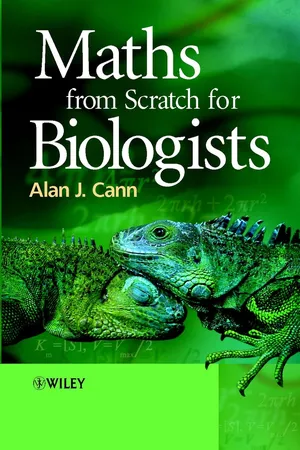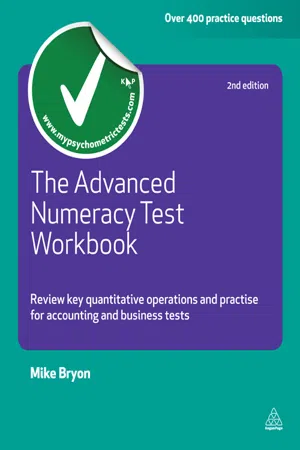Highest Common Factor
The Highest Common Factor (HCF) is the largest positive integer that divides two or more numbers without leaving a remainder. It is also known as the Greatest Common Divisor (GCD). Finding the HCF is important in simplifying fractions and solving problems in number theory and algebra.
4 Key excerpts on "Highest Common Factor"
- eBook - ePub
- Alan J. Cann(Author)
- 2013(Publication Date)
- Wiley(Publisher)
...Factors are separated by multiplication signs. Note that the number 1 is the factor of every number. All factors of a number can be divided exactly into that number. 2.6. Lowest common multiple and greatest common factor When manipulating fractions you frequently need to find these two terms – you will see examples of this below. To find the lowest common multiple (LCM) of two numbers, make a table of multiples (e.g. 2 and 3; see Table 2.2). To find the greatest common factor (GCF), meaning numbers or expressions by which a larger number can be divided exactly (‘factoring’), make a table of factors (e.g. 8 and 12; see Table 2.3). Table 2.2 Table of multiples Multiples of 2 Common multiples Multiples of 3 2 4 6 – – – 6 – 3 – 6 9 Table 2.3 Table of factors Factors of 8 Common factors Factors of 12 1 2 – 4 8 – 1 2 – 4 – – 1 2 3 4 6 12 2.7. Adding and subtracting fractions To be able to add or subtract fractions to or from fractions, the denominators must be the same (‘common’): cannot be added, but can. To find a common denominator so you can add or subtract fractions, find the LCM of all the denominators involved. Then, make the denominators equal the LCM by multiplying both the denominator and numerator by the corresponding factor of the LCM. Whenever you manipulate fractions, the final step is to reduce the answer to the lowest terms: 1. Factor the numerator. 2. Factor the denominator. 3. Find the fraction mix that equals 1. Example Add The LCM of 3 and 5 (the denominators) is 15. Both denominators must equal the LCM, so multiply 3 by 5, and 5 by 3. Now both denominators are the same (‘common’). To avoid altering the problem, multiply the numerators by the same factor as their respective denominators. This is the same as multiplying each fraction by 15/15, i.e. by 1. Now the denominators the same, add the fractions together. You cannot reduce this fraction further, i.e...
- eBook - ePub
Math Intervention 3-5
Building Number Power with Formative Assessments, Differentiation, and Games, Grades 3-5
- Jennifer Taylor-Cox(Author)
- 2016(Publication Date)
- Routledge(Publisher)
...Place pencil point through the paper clip at the center of the spinner. Holding the pencil securely with one hand, spin the paper clip with the other hand. Finding Common Factors What is the Finding Common Factors Concept? A factor of a number will divide that number evenly. For example, 9 is a factor of 18 because 18 can be divided by 9 without any remainders or fractional parts of a number. Eighteen has other factors, too. It is also divided evenly by 6 and 3, also by 1 and itself. The factors of 18 are 1, 2, 3, 6, 9, 18. If a number is only divisible by 1 and itself, it is a prime number. Often the task is to find common factors of two or more numbers. For example, 5 is a common factor of 30 and 20 because 5 is a factor of 30 and of 20. In fact, 1, 2, 5, 10 are all common factors of 30 and 20. If the task is to find the greatest common factor (GCF) of 30 and 20, we compare the factors of 30 and the factors of 20 to find the largest common factor, which is 10. CCSS Operations and Algebraic Thinking Formative Assessment To find out if a student understands the finding factors concept ask the student to name at least five factors of the following numbers: 12 50 48 Then ask the student to find at least two common factors of the following pairs of numbers: 15, 35 12, 18 36, 16 Then ask the student to find the GCF of the following numbers: 9, 12, 24 18, 48, 30 33, 7, 20 Successful Strategies As with finding the LCM, a beneficial way to help students find the GCF is to have students show the factors of each number in a skip counting pattern. When students examine these patterns it is easier to find the common factors and the GCF. Students may show the factors with numbers, words, or models...
- Caryl Lorandini(Author)
- 2021(Publication Date)
- Barrons Educational Services(Publisher)
...A prime number has exactly two factors: 1 and the number itself. A composite number has at least three factors. Composite numbers can be broken down into their prime parts or prime factors. Every composite number has a unique set of prime factors. We are going to decompose a composite number into its prime factors. Let’s start with 48. Pick any two factors of 48 other than 1 and 48. Keep making branches by doing the same process for the factors you chose. Circle the prime numbers as those are complete. Once all the branches have stopped with circles, you are finished. Gather your numbers for the solution. ANOTHER EXAMPLE: You can always check your answer by multiplying. EXAMPLE 8.2 1) Find the prime factorization of the following: a) 36 b) 42 c) 96 SOLUTIONS 1) a) 2 2 × 3 2 b) 2 × 3 × 7 c) 2 5 × 3 8.3 What Are Common Factors and Multiples? DEFINITIONS Common factor A number, polynomial, or quantity that evenly divides into two or more numbers or algebraic expressions. Greatest common factor (GCF) The greatest number or expression that is a factor of two or more numbers or expressions. Multiple The product of a given whole number and any other whole number. Common multiple A whole number that is a multiple of two or more given numbers. Least common multiple. (LCM) The smallest number, greater than zero, that is a multiple of two or more numbers. Common factors are really just like they sound: factors that are the same. This is often used in reducing fractions. To find a common factor you can look at both lists of factors. For example: The common factors are the factors on both lists: 1, 2, 4. The greatest common factor would be 4, since it is the greatest number on both lists. Another way to find the greatest common factor would be to decompose the numbers to their prime factors. The factors that are common to both lists are 2 × 2, which you multiply to get the GCF of 4. Let’s try it with three numbers: The common factors are 1, 2, 3, and 6...
- eBook - ePub
The Advanced Numeracy Test Workbook
Review Key Quantative Operations and Practise for Accounting and Business Tests
- Mike Bryon(Author)
- 2011(Publication Date)
- Kogan Page(Publisher)
...Answers and explanations Test 1: Key quantitative operations Q1 Fraction Decimal Percentage 3 / 4 0.75 75% 1 / 5 0.2 20% 3 / 5 0.6 60% 3 / 8 0.375 37.5% 1 / 4 0.25 25% Q2 Answer C. Explanation Simplifies to 1 / 4, Highest Common Factor (HCF) is 8. Q3 Answer C. Explanation HCF is 22. Q4 Answer A. Explanation HCF is 6. Q5 Answer B. Explanation HCF is. 13. Q6 Answer D. Explanation 3 / 12 + 8 / 12 = 11 / 12, which does not simplify any further. Q7 Answer A. Explanation 9 / 24 + 20 / 24 = 29 / 24 =. 1 5 / 24. Q8 Answer B. Explanation 3 / 6 + 1 / 6 = 4 / 6 = 2 / 3. Q9 Answer D. Explanation 4 / 12 − 3 / 12 = 1 / 12. Q10 Answer B. Explanation 25 / 30 − 9 / 30 = 16 / 30 = 8 / 15. Q11 Answer C. Explanation Multiply the numerators and the denominators, which gives 10 / 30 = 1 / 3, but you can simplify first,. ie 2 / 5 × 5 / 6 cancels out to 1 / 1 × 1 / 3 = 1 / 3. Q12 Answer A. Explanation 2 / 7 × 3 / 4 = 6 / 28 = 3 / 14. Q13 Answer C. Explanation A factor is a whole number that is a multiple without remainder. Q14 Answer C. Explanation The factors of 12 are 1, 2, 3, 4, 6, 12. The factors of 18 are 1, 2, 3, 6, 9, 18. So the common factors are 1, 2, 3, 6. Q15 Answer D. Explanation To multiply powers with the same base, add the powers. Q16 Answer B. Explanation To divide powers with the same base value, subtract the powers. Q17 Answer A. Q18 Answer C. Q19 Answer B. Q20 Answer D. Explanation Suggested answer A gives the volume of a square, B the volume of a cylinder. Q21 Answer D. Explanation 16 has more factors than 1 and itself. Its factors are 1, 2, 4, 8, 16. Q22 Answer C. Explanation They are 1, 2, 4, 5, 10, 20. Q23 Answer B. Explanation The base number must be multiplied by itself; then the sum of the first multiplication must be multiplied by the base number again. This must continue for as many times as the index value...



